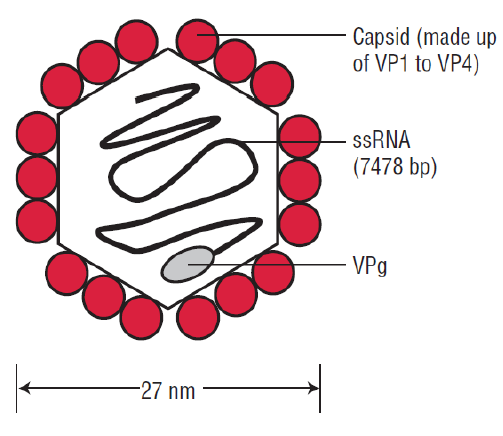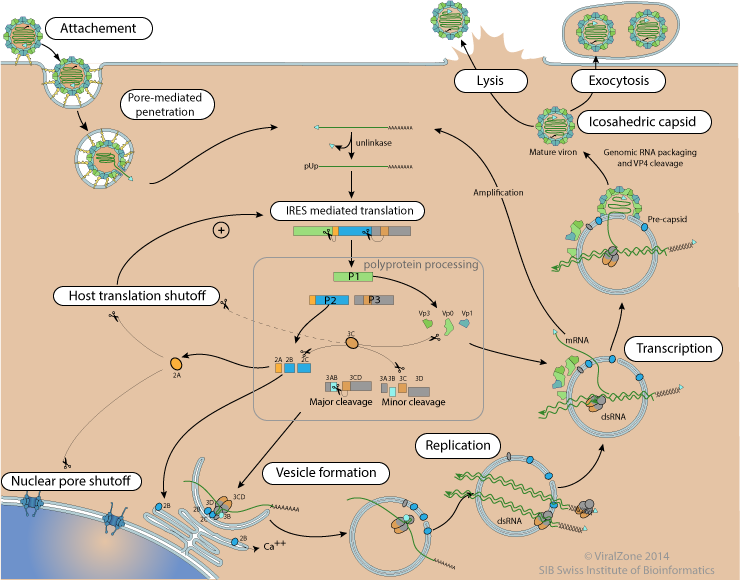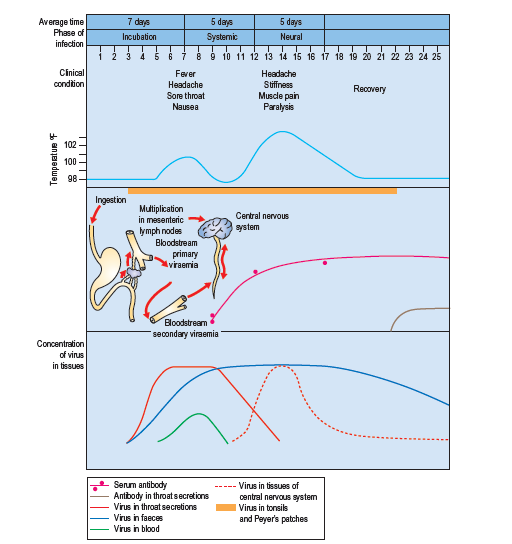Your browser does not fully support modern features. Please upgrade for a smoother experience.
Please note this is an old version of this entry, which may differ significantly from the current revision.
Poliovirus is a member of a family of viruses called the Picornaviridae.
- Polio Virus
- Picornaviridae
- poliomyelitis
1. Structure of Polio Virus

- Poliovirus is a member of a family of viruses called the Picornaviridae.
- Virions are spherical in shape with a diameter of about 27nm.
- The particles are simple in that they are composed of a protein shell surrounding the naked RNA genome.
- The genome is monopartite, linear ssRNA(+) genome of 7.2-8.5 kb, polyadenylated, composed of a single ORF encoding a polyprotein.
- The capsids are composed of four structural proteins: VP1, VP2, VP3, and VP4.
- The basic building block of the picornavirus capsid is the protomer, which contains one copy each of VP1, VP2, VP3, and VP4.
- The shell is formed by VP1 to VP3, and VP4 lies on its inner surface.
- The virus particles lack a lipid envelope, and their infectivity is insensitive to organic solvents.
2. Genome of Polio Virus
- Polio virus genome can be divided into three parts
- a 5′ noncoding region (NCR) that comprises approximately 10% of the genome, is uncapped, and is covalently linked at the 5′ terminus to viral protein VPg
- a single open reading frame that appears to encode all of the viral proteins, with regions designated as P1 for capsid proteins and P2 and P3 for nonstructural proteins
- a short 3′ NCR terminating in a polyA tail.

- The genomes vary in length from 7,209 to 8,450 bases.
- The 5′-noncoding region contains the internal ribosome entry site (IRES), an element that directs translation of the mRNA by internal ribosome binding.
- The regions P1 contains four segments for structural proteins which make up the capsid protein; 1A-VP4, 1B- VP2, 1C-VP3, 1D-VP1.
- P2 comprises of three non structural proteins; 2A, 2B, 2C which play a role in viral replication.
- P3 makes up four non structural proteins
- 3A- anchors the replication complex to cell membrane
- 3B- it is VPg protein
- 3C- it is cysteine protease that cleaves the protein from polypeptides
- 3D- it is RNA dependent RNA Polymerase.
3. Epidemiology of Polio Virus

- Poliomyelitis has had three epidemiologic phases: endemic, epidemic, and the vaccine era.
- Before global eradication efforts began, poliomyelitis occurred worldwide—year-round in the tropics and during summer and fall in the temperate zones.
- Winter outbreaks were rare.
- The disease occurs in all age groups, but children are usually more susceptible than adults because of the acquired immunity of the adult population.
- In developing areas, where living conditions favor the wide dissemination of virus, poliomyelitis is a disease of infancy and early childhood (“infantile paralysis”).
- In developed countries, before the advent of vaccination, the age distribution shifted so that most patients were older than age 5 years, and 25% were older than age 15 years.
- The case fatality rate is variable and is highest in the oldest patients and may reach from 5% to 10%.
- Before the beginning of vaccination campaigns in the United States, there were about 21,000 cases of paralytic poliomyelitis per year.
- Humans are the only known reservoir of infection.
- In temperate zones with high levels of hygiene, epidemics have been followed by periods of little spread of virus until sufficient numbers of susceptible children have grown up to provide a pool for transmission in the area.
4. Replication of Polio Virus

- Virus binds to a cellular receptor and the genome is uncoated.
- VPg is removed from the viral RNA, which is then translated.
- The polyprotein is cleaved nascently to produce individual viral proteins.
- RNA synthesis occurs on membrane vesicles.
- Viral (+) strand RNA is copied by the viral RNA polymerase to form full-length (–) strand RNAs, which are then copied to produce additional (+) strand RNAs.
- Early in infection, newly synthesized (+) strand RNA is translated to produce additional viral proteins.
- Later in infection, the (+) strands enter the morphogenetic pathway.
- Newly synthesized virus particles are released from the cell by lysis.
5. Pathogenesis of Polio Virus

- The mouth is the portal of entry for the virus, transmitted by fecal oral route on ingestion of contaminated water.
- Virus initially multiply in the oropharynx and gastrointestinal mucosa.
- The virus is regularly present in the throat and in the stools before the onset of illness.
- Virions are resistant to acidity of stomach and to lytic activities of the protease and other enzymes of the intestinal tract and bile.
- On entering the body, the virus infects and multiplies in the tonsils and Peyer’s patch of ileum.
- The incubation period is 9-12 days.
- The virus then spreads to regional lymph nodes and enters the blood causing primary viremia.
- Antibodies to the virus appear early in the disease, usually before paralysis occurs.
- The antibodies are produced to prevent infection from spreading.
- On continued infection and multiplication of virus in the ReticuloEndothelial System (RES), it invades the blood stream causing secondary viremia.
- During this period of viremia, the poliovirus crosses the blood brain barrier and gain access to the brain.
- The virus shows tissue tropism by specifically combining with neural cells.
- The virus recognizes the receptor present on the anterior horn of spinal cord, dorsal root ganglia and motor neurons.
- The destruction of motor neurons leads to paralysis.
- The virus also infects brain stem causing bulbar poliomyelitis.
6. Clinical Manifestations of Polio Virus
- The earliest features associated with phase of viremia consist of fever, malaise, headache, drowsiness, constipation, and sore throat and lasts for 1 to 5 days.
- Incubation period is usually 10 days but may vary from 4 days to 4 weeks.
Asymptomatic illness
- It is caused as a result of viral infection confined to the oropharynx and the intestine.
Abortive poliomyelitis
- It is minor illness occurring in approximately 5% of infected people.
- It is febrile illness characterized by fever, headache, sore throat, loss of appetite, vomiting, and abdominal pain.
- Neurological symptoms are typically absent.
Non paralytic poliomyelitis
- Some people who develop symptoms from the poliovirus contract a type of polio that doesn’t lead to paralysis (abortive polio).
- This usually causes the same mild, flu-like signs and symptoms typical of other viral illnesses.
- Signs and symptoms, which can last up to 10 days, include: Fever, sore throat, headache, vomiting, fatigue, back pain or stiffness, neck pain or stiffness, pain or stiffness in the arms or legs and muscle weakness or tenderness.
Paralytic poliomyelitis
- Initial signs and symptoms of paralytic polio, such as fever and headache, often mimic those of non-paralytic polio.
- Within a week, however, other signs and symptoms appear, including: Loss of reflexes, severe muscle aches or weakness and loose and floppy limbs (flaccid paralysis)
Post poliomyelitis syndrome
- Post-polio syndrome is a cluster of disabling signs and symptoms that affect some people years after having polio.
- Common signs and symptoms include: Progressive muscle or joint weakness and pain, fatigue, muscle wasting (atrophy), breathing or swallowing problems, sleep-related breathing disorder; such as sleep apnea, and decreased tolerance of cold temperatures.
Bulbar poliomyelitis
- This is caused due to involvement of the cranial nerves, most commonly 9th, 10th, and 12th.
- This condition tends to be more severe with involvement of the muscles of the pharynx, vocal cords and respiration.
- The condition may cause death in 75% of the patient.
This entry is sourced from https://microbenotes.com/polio-virus/
This entry is offline, you can click here to edit this entry!
